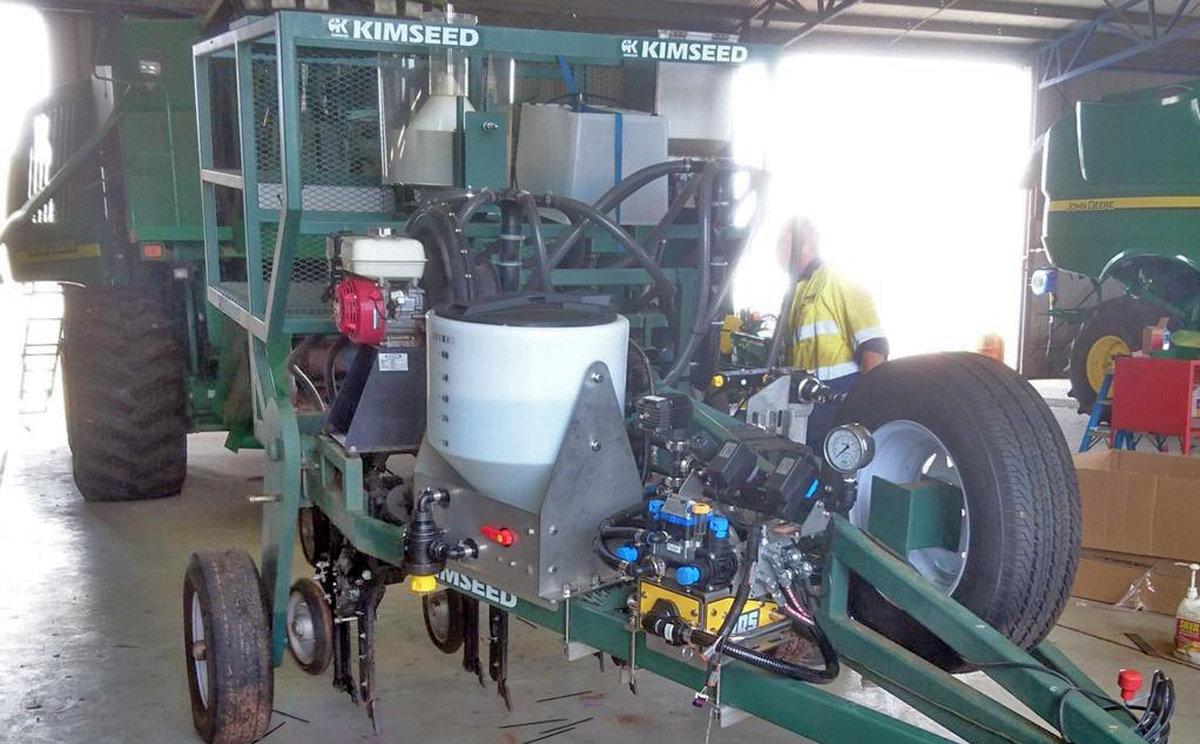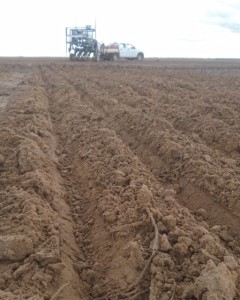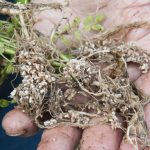Correcting soil pH with liquid lime & dolomite
Acidity related issues caused by low soil pH levels is a major issue for broadacre farmers across Australia, agronomist Leigh Nairn is testing the impact of banding liquid lime and dolomite products in the Mid West cropping areas of Western Australia.
WA agronomist and farmer Leigh Nairn is more than halfway through a five-year replicated trial that tests the effect of liquid banding on soil acidity and aluminium toxicity.
The trials, which began in 2014, test various types of liquid lime and dolomite applied in-furrow, with the aim of neutralising the soil, creating a healthy root zone and increasing production.
“WA soils are quite infertile; the best we get is some red loam and sand over clay or gravel,” said Leigh. “Soil pH has also decreased with the use of acidifying fertilisers, like ammonium sulphate, MAPs and DAPs and growers are trying to fix that by spreading lime, but it’s a slow process. It can take anywhere from five to ten years to see any impact from lime spreading at depth.
“These trials are about using liquid banding to boost a farm’s liming program and work out which products have the greatest impact on crop growth in low pH environments.
“While nothing will replace spreading lime, I believe banding liquids is another tool growers can use. It’s about using liquid to speed things up.”
An agronomist for more than a decade with experience working for Elders, Syngenta Crop Protection and CRT, Leigh currently works as an agronomist for Landmark in Northampton, north of Geraldton, as well as supporting his father Don Nairn with the family’s cropping enterprise.
Leigh’s soil acidity and pH amelioration trial is part of a wider program that includes testing liquid inoculants, fungicides and non-wetting agents. Overall, he conducted 30 main research trials in 2016, including one for Bayer CropScience that tested liquid fungicides for disease control.
There are a lot of options with liquids; far more than just nitrogen
“There are a lot of options with liquids; far more than just nitrogen,” said Leigh. “My main passion is in pH amelioration. It’s about trying to band some type of carbonate to increase pH or eliminate some of the aluminium that’s at depth.
“Our trials have been going for two to three years now. We’re taking regular pH readings at those trial sites and we can see that it’s working.”
Leigh began the liquid trials using another grower’s Liquid Systems (SA) unit on 12m strips. In 2016 he converted to Liquid Systems’ (SA) VRS (Verifiable Research System) mounted on a seeder and towed by a ute, with seeding depth ranging from 2 to 5cm.
Last year’s trials were conducted on two sites in Northampton, one primarily red loam and the other deep yellow sand. The trial included 216 wheat plots on each site, with each plot 20m long at seeding, later reduced to 12 to 15m of harvested area.
Two of the liquid products included in the trial were Calbud and Calcium silicate (CaSi), each replicated three times at each site. Calbud is a liquid dolomite formulation with trace elements, which is being trialled for its effectiveness in increasing pH, while Leigh tested Calcium silicate for its ability to disperse aluminium. Aluminium, which impedes root growth, is an issue in low pH soils, as drops in pH make the aluminium soluble.
“Some of the results from the Calbud trials showed pH as low as 4.5 in the top 10cm increasing to a pH of 5.6,” said Leigh. “Results also showed an impact on pH in the 10 to 20cm zone, which is good news.”
From a cost perspective, Leigh says the results show a positive return on investment.
“If we look at banding 4l/ha of Calbud, it costs $4.25/litre or $8.50/ha,” said Leigh. “We’ve got to make sure that it’s economically viable and from what we’ve seen so far, the economics are working.
Not only are we increasing the pH with these products, we’re getting a yield benefit too.
“Not only are we increasing the pH with these products, we’re getting a yield benefit too.”
In 2016, results showed that applications of either Calbud or CaSi had a benefit to yield. The average yield on the control sites was 3.66t/ha reaching 4.13t/ha for sites with an application of Calcium silicate at 5l/ha.
| Treatment | Av. Yield | Net GM $/ha |
| Nil | 3.66 | $820.06 |
| Calbud @ 2ltr | 4.07 | $903.18 |
| Calbud @ 4ltr | 4.08 | $896.92 |
| CaSi @ 5ltr | 4.139 | $867.64 |
The cost of applying the liquid products ranged from $8.50/ha for Calbud at 2 litres up to $59.5/ha for Calcium silicate. The net gross margin ranged from $867/ha to $903/ha, compared to an average $820/ha for the control sites.
Leigh has also made modifications to the seeding bar to experiment with applying the liquid above and below the seed. “All trials show that we need to band the liquid lime and dolomite below, but very close the seed, except when we’re looking at UAN or wetting agents,” he said. For example, some of the trials based on the use of detergents and non-wetting agents showed benefits from an application on top of the furrow.
“We can also split the UAN applications, putting 10l/ha above the seed and 40l/ha below. If we get some rain, it can cause the nitrogen to leach down through the soil profile, so the UAN placed above the seed can possibly help to get the crop established. If it’s all placed below the seed, nitrogen leaching can mean that the roots don’t catch up to the nutrients.”
As a result of the trials, Leigh sees an opportunity for growers to apply liquid lime and dolomite every year. “It’s not about stopping your liming program, but banding liquid lime or dolomite year in year out to speed up the process,” said Leigh. “On my family’s farm, I’m using them like I do fertiliser. It’s no different to using MAP or DAP every year to get the crop up.
“The benefit of increasing soil pH is a healthier crop; neutralising soil pH means we’re making more nutrients like trace elements available in the soil. It’s like a win-win.”
Leigh believes the trials already show that growers need to broaden their thinking when it comes to liquids.
“In the early days of liquid, it was just about getting as much nitrogen down the tube up-front, but now we’re looking at what else we can do to fix some of the other issues we’ve got.
There are endless ways you can use liquid to improve crop health and nutrition, including pH ameliorants that we’ve been testing, disease prevention products to control powdery mildew, smuts and Rhizoctonia and crop health products.
“There are endless ways you can use liquid to improve crop health and nutrition, including pH ameliorants that we’ve been testing, disease prevention products to control powdery mildew, smuts and Rhizoctonia and crop health products.
“If growers think outside the box, they can really start to make improvements to their bottom line.
“I think growers are starting to see that liquids are a huge part of the future of farming. There are so many products that can be used to fix a wide range of issues.”









